

***Description for this plant available with future update!*** Grusonia clavata is also known as Dagger Club Cholla Cactus (Cold Hardy).
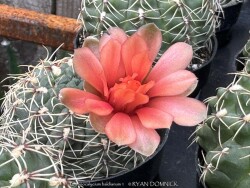

***Description for this plant available with future update!*** Gymnocalycium baldianum is also known as Chin Cactus (Tropical)>>>>>> With extremely well drained soils and proper siting, this cactus seems to take our excess rainfall in Eastern Kansas. These and other hardy barrel cacti are perfect for a dry mounded xeriscape gardens under south facing roof overhangs where it gets no winter moisture. We are also testing this outside in our Lawrence, KS (zone 6a) crevice garden among other cold-hardy cacti, succulents, and yucca! Watch for future updates-Jan-2025
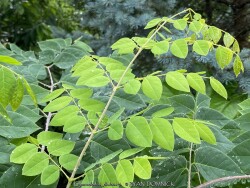

***Tree descriptions available with future update!***Kentucky Coffeetree, is also known as Gymnocladus dioicus


Elephant's Tongue Plant (Haemanthus albiflos) has attractive exceptionally wide medium green, wide, glossy, curved foliage along with occasional white flowers. It is native to seasonal semi-dry coastal cliffs in South Africa hardy to 23-25 degrees F. It is best used as a houseplant or summer patio plant in Kansas. Place in part to full shade in areas where occasional extra watering can happen including that which comes from rainfall. Repotting may or may not be needed depending on how large you want the plant to grow; plants can continue to grow thicker and tolerate extremely root-bound pots. Potted plants are hardy to at least 30 degrees F for a short time but try not to miss the first light frost. Move into a cold garage, basement, or bright window over the winter with occasional watering. Flowering is more reliable with root-bound plants but rarely occurs. As a winter house plant, it will look presentable all winter long with just a few waterings. As a permanent house plant, provide bright light and allow the soil to dry between waterings for many years (even decades) of carefree enjoyment. Potted plants grow very slow and are very low maintenance needing only old leaves removed once per year. Elephant's tongue is relatively rare and will command a higher price than most other houseplants.
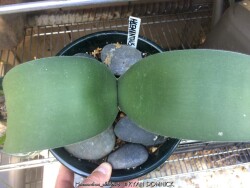

Elephant's Tongue Plant (Haemanthus albiflos) has attractive exceptionally wide medium green, wide, glossy, curved foliage along with occasional white flowers. It is native to seasonal semi-dry coastal cliffs in South Africa hardy to 23-25 degrees F. It is best used as a houseplant or summer patio plant in Kansas. Place in part to full shade in areas where occasional extra watering can happen including that which comes from rainfall. Repotting may or may not be needed depending on how large you want the plant to grow; plants can continue to grow thicker and tolerate extremely root-bound pots. Potted plants are hardy to at least 30 degrees F for a short time but try not to miss the first light frost. Move into a cold garage, basement, or bright window over the winter with occasional watering. Flowering is more reliable with root-bound plants but rarely occurs. As a winter house plant, it will look presentable all winter long with just a few waterings. As a permanent house plant, provide bright light and allow the soil to dry between waterings for many years (even decades) of carefree enjoyment. Potted plants grow very slow and are very low maintenance needing only old leaves removed once per year. Elephant's tongue is relatively rare and will command a higher price than most other houseplants.
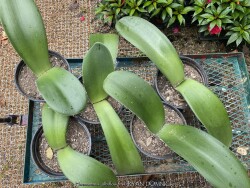

Elephant's Tongue Plant (Haemanthus albiflos) has attractive exceptionally wide medium green, wide, glossy, curved foliage along with occasional white flowers. It is native to seasonal semi-dry coastal cliffs in South Africa hardy to 23-25 degrees F. It is best used as a houseplant or summer patio plant in Kansas. Place in part to full shade in areas where occasional extra watering can happen including that which comes from rainfall. Repotting may or may not be needed depending on how large you want the plant to grow; plants can continue to grow thicker and tolerate extremely root-bound pots. Potted plants are hardy to at least 30 degrees F for a short time but try not to miss the first light frost. Move into a cold garage, basement, or bright window over the winter with occasional watering. Flowering is more reliable with root-bound plants but rarely occurs. As a winter house plant, it will look presentable all winter long with just a few waterings. As a permanent house plant, provide bright light and allow the soil to dry between waterings for many years (even decades) of carefree enjoyment. Potted plants grow very slow and are very low maintenance needing only old leaves removed once per year. Elephant's tongue is relatively rare and will command a higher price than most other houseplants.
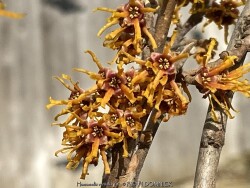

***Shrub descriptions available with future update!*** Hamamelis vernalis is also known as Ozark Witchhazel Shrub.
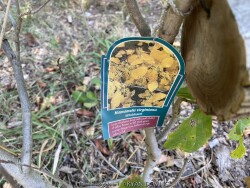

***Tree descriptions available with future update!*** Hamamelis virginiana is also known as Virginiana Yellow Tree Witchhazel
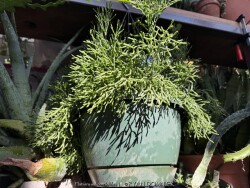

The Dancing Bones Cactus, also known as Rhipsalis salicornioides, is a epiphyte jungle cactus native to South America. . It produces thin, flat, succulent leaves that resemble a beer bottle. Originating from a dry climates but not a true desert, it is much more moisture tolerant than a typical derert barrel cactus. Succulents are usually spineless and grown for their beautiful shapes, color and texture. Cacti are known for their spines, unusual shapes and beautiful flowers. Both succulents and cacti store water in their fleshy tissues. And can survive long periods without water. Cacti and succulents are usually grown as a deck/patio plant or house plant in Kansas. Grow in full sun with little to no extra watering except that which comes from rainfall. Generally, plants may be brought out in Late May through Early October in our zone 6a Lawrence, KS climate. To play is safe, potted plants are best moved in before autumn leaves begin to drop and before night temperatures get below 45 degrees F. It is very important to avoid the combination of wet and cold. Move to a bright interior window over the winter with little to no watering and keep above 50 degrees F. As a winter house plant, it will look presentable all winter long with little to no waterings. As a permanent house plant, provide bright light and allow the soil to dry completely between waterings and you will get many years of carefree enjoyment. Plants grown permanently indoors may eventually begin to elongate stretching for light and lose their spine color. It can be hard to reproduce the intense UV sunlight they need when growing indoors so moving outside for the summer is best. Generally if moving outside for the summer, allow 1-2 weeks of part shade or morning sun before placing in full sun. Plants with time to acclimate will thrive in full sun but be careful not to rush it or sunburning may occur. Repotting may or may not be needed depending on how large you want the plant to grow; plants can continue to grow taller and tolerate extremely root-bound pots but may need wind bracing. If repotting, make sure to use a sharp draining low organic cactus mix with plenty of sand and perlite but avoid peat moss. The “soil” most commercial cacti are potted in to too peaty and light weight. This soil becomes hydrophobic and shrinks after becoming bone dry and difficult to re wet again. Cacti never grow in peat-based soils in nature; this “Soil” is only good for shipping because of the light weight. Potted plants are very low maintenance but watch for scale and mealybugs that may hide beneath the cover of spines. The best pest removal approach is to periodically wash the cactus off. Achieve this with a water nozzle or hose breaker turned mostly off to increase the pressure from the blast of water. This high-pressured water kills the pests without damaging the thick cactus skin. Here are some little-known or rare factoids about cacti: 1. The "spines" are actually modified leaves filled with sap at first, then quickly drying out to form the spines! 2. Many cacti have bright colored flowers that mainly attract bees, while some tubular flowering types attract hummingbirds and bats. 3. Late on the evolutionary timeline, cacti fossils are rare to non-existent. Cacti are native almost exclusively to the Americas, while succulents can include a much larger plant palette be from any dry area in the world. 4. Some cactus plants have been known to survive more than 2 years without water. 5. Some cacti first evolved in a dry climate that later became wetter again. For example: several jungle species live as epiphytes in trees to achieve the fast drainage they need.
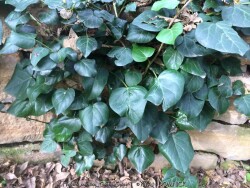

English Ivy (Hedera helix) is planted for its evergreen dark green foliage. This is one of the most deep shade tolerant plants available. It makes a durable evergreen groundcover that starts off slow, but grows quickly after a few years to forms a dense, weed-smothering mat of foliage. As one of the most dry-shade tolerant plants there is, it's thick leathery leaves seem to handle everything nature has to throw at it! That being said, beware that this is an extremely vigorous plant that crowds out most weeds and is itself weed-like, with a very spreading growth habit. After establishment, it is high maintenance if it has already filled the space and you don't want it to spread any further: it even resists Round-up! It will climb trees if you allow it, generally using it for support to allow its mature form to develop and flowering to occur. For the home garden, the species is generally too aggressive to mix with other plants. We have more requests on "how to eradicate it" than "wanting to purchase it".
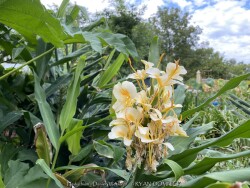

Hardy Ginger (Hedychium) are typically grown for their late summer flowers and vertical wide-leaf foliage. The plants are large tropical and subtropical herbaceous perennials with a rhizomatous rootstock native to areas with a summer monsoon and dry winter. They can be grown as flowering summer patio plants. If growing as a potted plant and trying to overwinter, allowing the foliage to frost is ok, it will not kill the root system. However, do not allow the pot with rootball to freeze solid or go below 20 degrees for more than a few hours; move into a cold garage or basement over the winter with no watering. Cut back and allow to go dormant and place entire pot back out in April or May with a time-release fertilizer. Another more labor intensive way to overwinter cannas is to remove them from the dirt, dust with fungicide, place in box with sawdust, and keep in the refrigerator. We consider this method old-fashioned and too much work but ok if you only want to save a few pieces. If digging from the ground, just save a big chunk with the dirt intact and place into a large pot in the garage. During the growing season, fertilize, water regularly, and place in full sun. You may also plant these in the ground for an enormous tropical effect! It is possible to overwinter these in the ground in Kansas by mulching 6-12" thick over deeply planted rhizomes. New growth may be slightly delayed but probably quick to regain full height. Native habitat for most hedychiums aligns well with our dry winters and warm humid summers. In our trial gardens in Lawrence, KS (zone 6a), we will be testing several varieties in 2022-2023. Famous plantsman, Tony Avent, owner of Plant Delights Nursery in Raleigh, North Carolina, advised us that hedychiums should survive fine here in the ground when mulched like cannas.
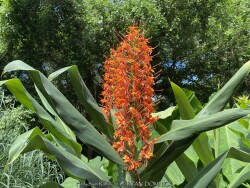

Hardy Ginger (Hedychium) are typically grown for their late summer flowers and vertical wide-leaf foliage. The plants are large tropical and subtropical herbaceous perennials with a rhizomatous rootstock native to areas with a summer monsoon and dry winter. They can be grown as flowering summer patio plants. If growing as a potted plant and trying to overwinter, allowing the foliage to frost is ok, it will not kill the root system. However, do not allow the pot with rootball to freeze solid or go below 20 degrees for more than a few hours; move into a cold garage or basement over the winter with no watering. Cut back and allow to go dormant and place entire pot back out in April or May with a time-release fertilizer. Another more labor intensive way to overwinter cannas is to remove them from the dirt, dust with fungicide, place in box with sawdust, and keep in the refrigerator. We consider this method old-fashioned and too much work but ok if you only want to save a few pieces. If digging from the ground, just save a big chunk with the dirt intact and place into a large pot in the garage. During the growing season, fertilize, water regularly, and place in full sun. You may also plant these in the ground for an enormous tropical effect! It is possible to overwinter these in the ground in Kansas by mulching 6-12" thick over deeply planted rhizomes. New growth may be slightly delayed but probably quick to regain full height. Native habitat for most hedychiums aligns well with our dry winters and warm humid summers. In our trial gardens in Lawrence, KS (zone 6a), we will be testing several varieties in 2022-2023. Famous plantsman, Tony Avent, owner of Plant Delights Nursery in Raleigh, North Carolina, advised us that hedychiums should survive fine here in the ground when mulched like cannas. Hedychium 'Raffillii' features bright orange flowers that can reach 18 inches above the 5-6 feet canes.
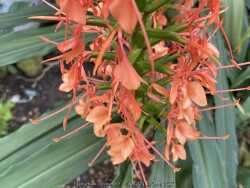

Hardy Ginger (Hedychium) are typically grown for their late summer flowers and vertical wide-leaf foliage. The plants are large tropical and subtropical herbaceous perennials with a rhizomatous rootstock native to areas with a summer monsoon and dry winter. They can be grown as flowering summer patio plants. If growing as a potted plant and trying to overwinter, allowing the foliage to frost is ok, it will not kill the root system. However, do not allow the pot with rootball to freeze solid or go below 20 degrees for more than a few hours; move into a cold garage or basement over the winter with no watering. Cut back and allow to go dormant and place entire pot back out in April or May with a time-release fertilizer. Another more labor intensive way to overwinter cannas is to remove them from the dirt, dust with fungicide, place in box with sawdust, and keep in the refrigerator. We consider this method old-fashioned and too much work but ok if you only want to save a few pieces. If digging from the ground, just save a big chunk with the dirt intact and place into a large pot in the garage. During the growing season, fertilize, water regularly, and place in full sun. You may also plant these in the ground for an enormous tropical effect! It is possible to overwinter these in the ground in Kansas by mulching 6-12" thick over deeply planted rhizomes. New growth may be slightly delayed but probably quick to regain full height. Native habitat for most hedychiums aligns well with our dry winters and warm humid summers. In our trial gardens in Lawrence, KS (zone 6a), we will be testing several varieties in 2022-2023. Famous plantsman, Tony Avent, owner of Plant Delights Nursery in Raleigh, North Carolina, advised us that hedychiums should survive fine here in the ground when mulched like cannas. Hedychium coccineum features orange flowers.
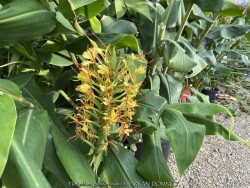

Hardy Ginger (Hedychium) are typically grown for their late summer flowers and vertical wide-leaf foliage. The plants are large tropical and subtropical herbaceous perennials with a rhizomatous rootstock native to areas with a summer monsoon and dry winter. They can be grown as flowering summer patio plants. If growing as a potted plant and trying to overwinter, allowing the foliage to frost is ok, it will not kill the root system. However, do not allow the pot with rootball to freeze solid or go below 20 degrees for more than a few hours; move into a cold garage or basement over the winter with no watering. Cut back and allow to go dormant and place entire pot back out in April or May with a time-release fertilizer. Another more labor intensive way to overwinter cannas is to remove them from the dirt, dust with fungicide, place in box with sawdust, and keep in the refrigerator. We consider this method old-fashioned and too much work but ok if you only want to save a few pieces. If digging from the ground, just save a big chunk with the dirt intact and place into a large pot in the garage. During the growing season, fertilize, water regularly, and place in full sun. You may also plant these in the ground for an enormous tropical effect! It is possible to overwinter these in the ground in Kansas by mulching 6-12" thick over deeply planted rhizomes. New growth may be slightly delayed but probably quick to regain full height. Native habitat for most hedychiums aligns well with our dry winters and warm humid summers. In our trial gardens in Lawrence, KS (zone 6a), we will be testing several varieties in 2022-2023. Famous plantsman, Tony Avent, owner of Plant Delights Nursery in Raleigh, North Carolina, advised us that hedychiums should survive fine here in the ground when mulched like cannas. Butterfly Ginger (Hedychium gardnerianum) is native to the Himalayas in India, Nepal, and Bhutan. The very fragrant pale yellow and red flowers are held in dense spikes above the foliage. Foliage and stems are massive; reaching 6-8 feet tall.
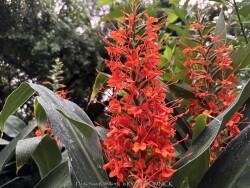

Hardy Ginger (Hedychium) are typically grown for their late summer flowers and vertical wide-leaf foliage. The plants are large tropical and subtropical herbaceous perennials with a rhizomatous rootstock native to areas with a summer monsoon and dry winter. They can be grown as flowering summer patio plants. If growing as a potted plant and trying to overwinter, allowing the foliage to frost is ok, it will not kill the root system. However, do not allow the pot with rootball to freeze solid or go below 20 degrees for more than a few hours; move into a cold garage or basement over the winter with no watering. Cut back and allow to go dormant and place entire pot back out in April or May with a time-release fertilizer. Another more labor intensive way to overwinter cannas is to remove them from the dirt, dust with fungicide, place in box with sawdust, and keep in the refrigerator. We consider this method old-fashioned and too much work but ok if you only want to save a few pieces. If digging from the ground, just save a big chunk with the dirt intact and place into a large pot in the garage. During the growing season, fertilize, water regularly, and place in full sun. You may also plant these in the ground for an enormous tropical effect! It is possible to overwinter these in the ground in Kansas by mulching 6-12" thick over deeply planted rhizomes. New growth may be slightly delayed but probably quick to regain full height. Native habitat for most hedychiums aligns well with our dry winters and warm humid summers. In our trial gardens in Lawrence, KS (zone 6a), we will be testing several varieties in 2022-2023. Famous plantsman, Tony Avent, owner of Plant Delights Nursery in Raleigh, North Carolina, advised us that hedychiums should survive fine here in the ground when mulched like cannas.
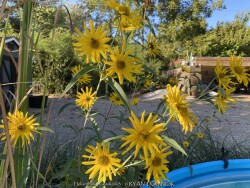

Maximilian's Sunflower is a very tall and showy wildflower native to the Great Plains in central North America and Canada. It has a distinctive fold down the mid-rib center of the narrow leaf. The leaf may be up to 12" long, slightly curved, and arranged in a whorl around the unbranching stems. In rich soils with average moisture, it reaches up to 10 feet tall and towers above surrounding vegetation when in bloom. In Eastern Kansas, typically our 40 inches of rainfall is sufficient without extra water. It is best suited for full sun and dry to medium soils to control height and to avoid floppiness. Like most other Sunflower species, Maximilian's Sunflower attracts a several different species of bees and butterflies. This species spreads by rhizomes and may spread too vigorously for most gardens, and therefore needs plenty of room. It is best used for naturalizing, roadway ditch plantings, buffer zones, or as as large isolated clumps. Cut or mow all foliage down in the winter, mowing around it during the growing season generally stops the yearly spread.
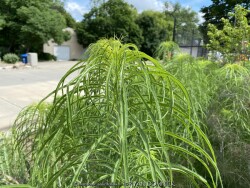

Willow-Leaved Sunflower is a herbaceous perennial with very fine textured leaves and golden sunflowers native to the central United States, primarily in the Great Plains and Ozark Plateau. Extremely fine textured leaves are a bright green and resemble Amsonia Hubrichtii. Upon close inspection, the foliage is quite a bit longer and sways in the breeze more readily. Mature plants have multiple and branched stems from the ground creating a nice bush like effect. This alone could be a main reason to grow this plant. In late summer, golden flowers emerge at the top of the plant covering the foliage for about 4 to 6 weeks. As with any plant in the Sunflower family, pollinators go crazy over the flowers. Willow-leaf sunflower thrives in most garden soils except extremely wet or extremely dry ones but prefers rocky outcrops with heavy soil. Full sun is needed to avoid possible floppiness, even then, some staking but be required if strong winds whip the tall flowering stalks. The only maintenance is at some point in the winter trim back to the ground. Use in the landscape as a specimen plant or a small grouping where are you really went to attract attention. Combine with any course textured plant or just about any other flower except other late blooming gold flowers. Several new cultivars exist with different shades of flowers and shorter, more compact growth heights.


***Description for this perennial available with future update!*** Heliopsis helianthoides var. scabra 'Burning Hearts' is also known as Burning Hearts Ox-eye Sunflower / False Sunflower.
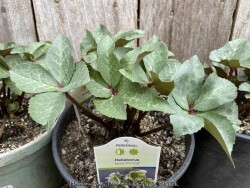

Lenten Rose (Helleborus) are the ultimate dry-shade plant for eastern Kansas landscapes. Most hellebores are native to mountainous wooded regions of Europe with limestone bedrock and calcareous, humus-rich soils. They have everything a gardener might ask for; beautiful spring flowers, dependable dark green foliage, evergreen during winter, appreciation for alkaline soils, and ease of care with very low maintenance. Hellebores are one of the first perennials to start growing in the spring with flowering occurring even with hard freezes. Flowers last incredibly long 2 to 3 months and finally turn greenish in June. No deadheading is needed because the foliage just absorbs the flower stalks as they fade. Summer and fall foliage is dark green, dependable, and pest-free. Evergreen foliage is hardy to about 0°F. If it gets colder than that, hellebores will be deciduous with no detrimental effects. Desirable self-seeding may gently occur around mother plants. Hellebores do have an Achilles heel however; they cannot tolerate wet or poorly drained soils, not even slightly. In areas with too much rainfall or poorly drained soils, foliage diseases and root rot are likely to occur. Hellebores are also not the best choice for full sun, while they will survive, they will get foliage burn in the summer when over 100°F in afternoon sun. With poisonous foliage, these plants resist deer and rabbit browsing. What a great plant for the dry shade garden! There are many improved flowering cultivars to choose from now. Helleborus 'Ivory Prince' is a selection chosen for its quick growing nature. Burgundy-pink buds open to creamy, white flowers that mature with pink highlights in early spring. Blooms face up and outward from the reddish stems over evergreen foliage. Prominent veining on leathery evergreen foliage is showy even when not in bloom. Great in our trial gardens to far.
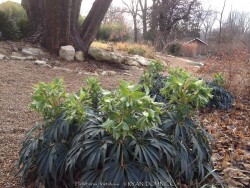

Bear Claw / Stinking Hellebore (Helleborus foetidus) is the ultimate dry-shade plant for eastern Kansas landscapes. Most hellebores are native to mountainous wooded regions of Europe and Asia with limestone bedrock and calcareous, humus-rich soils. They have everything a gardener might ask for; beautiful spring flowers, dependable dark green foliage, evergreen during winter, appreciation for alkaline soils, and ease of care with very low maintenance. Hellebores are one of the first perennials to start growing in the spring with flowering occurring even with hard freezes. Bear Claw Hellebore literally starts blooming in January and February in zone 6a. The drooping cup-shaped flowers appear in spring, and are yellowish-green, often with a purple edge to the five petal-like sepals on strongly upright stems. The flowers are very attractive to bees and other insects at a time of year when hardly any other plant (except Witchhazel / Hamamelis) is blooming. Despite its common name, it is not noticeably malodorous, although the foliage is pungent when crushed. Greenish flowers last incredibly long 2 to 3 months and finally turn brown in May and should be dead-headed. Summer and fall foliage is bear claw-like, dark green, dependable, and pest-free. Evergreen foliage is hardy to about -10°F with complete death occurring at about -15°F for unmulched plants. Desirable self-seeding will occur around mother plants. Individual plants of this species usually live for 3-4 years so it is advisable to allow a patch of different aged plants. Flowering usually occurs at 2-3 years. Hellebores do have an Achilles heel however; they cannot tolerate wet or poorly drained soils, not even slightly. In areas with too much rainfall or poorly drained soils, foliage diseases and root rot are likely to occur. Hellebores are also not the best choice for full sun, while they will survive, they will get foliage burn in the summer when over 100°F in afternoon sun. This hellebore is less adapted to consistent summer heat and humidity of zone 7b areas or South. With poisonous foliage, these plants resist deer and rabbit browsing. What a great plant for the dry shade garden! There are a few interesting and improved cultivars but are rarely available.
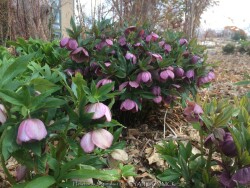

Lenten Rose (Helleborus) is the ultimate dry-shade plant for eastern Kansas landscapes. Most hellebores are native to mountainous wooded regions of Europe with limestone bedrock and calcareous, humus-rich soils. They have everything a gardener might ask for; beautiful spring flowers, dependable dark green foliage, evergreen during winter, appreciation for alkaline soils, and ease of care with very low maintenance. Hellebores are one of the first perennials to start growing in the spring with flowering occurring even with hard freezes. Flowers last incredibly long 2 to 3 months and finally turn greenish in June. No deadheading is needed because the foliage just absorbs the flower stalks as they fade. Summer and fall foliage is dark green, dependable, and pest-free. Evergreen foliage is hardy to about 0°F. If it gets colder than that, hellebores will be deciduous with no detrimental effects. Desirable self-seeding may gently occur around mother plants. Hellebores do have an Achilles heel however; they cannot tolerate wet or poorly drained soils, not even slightly. In areas with too much rainfall or poorly drained soils, foliage diseases and root rot are likely to occur. Hellebores are also not the best choice for full sun, while they will survive, they will get foliage burn in the summer when over 100°F in afternoon sun. With poisonous foliage, these plants resist deer and rabbit browsing. What a great plant for the dry shade garden! There are many improved flowering cultivars to choose from now.


Lenten Rose (Helleborus) is the ultimate dry-shade plant for eastern Kansas landscapes. Most hellebores are native to mountainous wooded regions of Europe with limestone bedrock and calcareous, humus-rich soils. They have everything a gardener might ask for; beautiful spring flowers, dependable dark green foliage, evergreen during winter, appreciation for alkaline soils, and ease of care with very low maintenance. Hellebores are one of the first perennials to start growing in the spring with flowering occurring even with hard freezes. Flowers last incredibly long 2 to 3 months and finally turn greenish in June. No deadheading is needed because the foliage just absorbs the flower stalks as they fade. Summer and fall foliage is dark green, dependable, and pest-free. Evergreen foliage is hardy to about 0°F. If it gets colder than that, hellebores will be deciduous with no detrimental effects. Desirable self-seeding may gently occur around mother plants. Hellebores do have an Achilles heel however; they cannot tolerate wet or poorly drained soils, not even slightly. In areas with too much rainfall or poorly drained soils, foliage diseases and root rot are likely to occur. Hellebores are also not the best choice for full sun, while they will survive, they will get foliage burn in the summer when over 100°F in afternoon sun. With poisonous foliage, these plants resist deer and rabbit browsing. What a great plant for the dry shade garden! There are many improved flowering cultivars to choose from now.


***Description for this perennial available with future update!*** Hemerocallis 'Alabama Jubilee' is also known as Alabama Jubilee Orange Daylily.


***Description for this perennial available with future update!***Buttered Popcorn Yellow Daylily, is also known as Hemerocallis 'Buttered Popcorn'
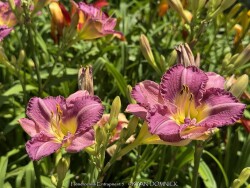

***Description for this perennial available with future update!*** Hemerocallis 'Entrapment' is also known as Entrapment Purple Daylily.
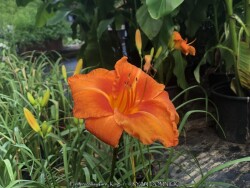

***Description for this perennial available with future update!***Fire King Orange Daylily, is also known as Hemerocallis 'Fire King'
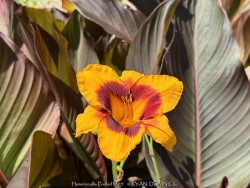

***Description for this perennial available with future update!*** Hemerocallis 'Fooled Me' is also known as Fooled Me Gold & Red Daylily.
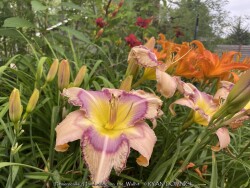

***Description for this perennial available with future update!***Handwritting on the Wall Multi-colored Daylily, is also known as Hemerocallis 'Handwritting on the Wall'
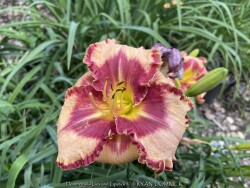

***Description for this perennial available with future update!*** Hemerocallis 'Lies and Lipstick' is also known as Hemerocallis Lies and Lipstick Pink & Red Daylily.
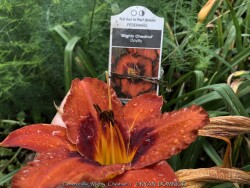

***Description for this perennial available with future update!***Mighty Chestnut Orange & Copper Daylily, is also known as Hemerocallis 'Mighty Chestnut'
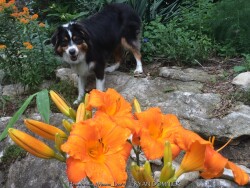

***Description for this perennial available with future update!***Moana Loa Orange Daylily, is also known as Hemerocallis 'Moana Loa'


***Description for this perennial available with future update!*** Hemerocallis 'Primal Scream' is also known as Primal Scream Orange Daylily >>>>>>>>>>>>All Proven Winners® plants are legally propagated, healthy and vigorous, true to name, and tagged with color pictures and growing information.


***Description for this perennial available with future update!***Red Razzmatazz Daylily, is also known as Hemerocallis 'Red Razzmatazz'
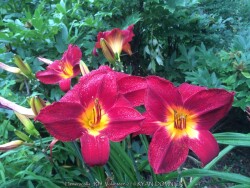

***Description for this perennial available with future update!***Red Volunteer Daylily, is also known as Hemerocallis 'Red Volunteer'
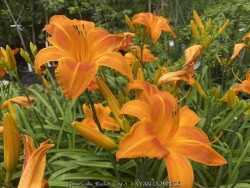

***Description for this perennial available with future update!*** Hemerocallis 'Rocket City' is also known as Rocket City Orange Daylily.


***Description for this perennial available with future update!***Ruby Spider Daylily, is also known as Hemerocallis 'Ruby Spider'


***Description for this perennial available with future update!***Ruby Stella Daylily, is also known as Hemerocallis 'Ruby Stella'
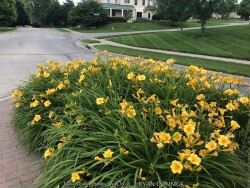

***Description for this perennial available with future update!***Stella De Oro Yellow Daylily, is also known as Hemerocallis 'Stella De Oro'
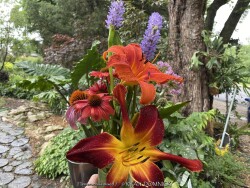

***Description for this perennial available with future update!***Daylily (Mixed Colors), is also known as Hemerocallis cultivars


Hemerocallis fulva is a great dry-shade groundcover useful under trees with competitive root systems. Growth in the spring is the most attractive with typical bright green daylily foliage. Orange flowers with red throat follow in summer for about a month. If dry in summer, it will go partially dormant and look bedraggled. If this happens, simply 'mow and regrow". With regular water in the fall, beautiful growth will resume. It can be invasive and should only be grown in a confined area or container. For the home garden, the species is generally too aggressive to mix with other plants. However, in a difficult dry-shade garden, it will thrive, flower, and be relatively tame. It is one of the few plants that can survive under an established Silver Maple!
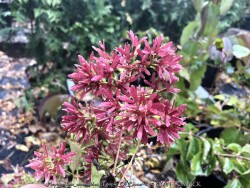

Hang on to your hat - Temple of Bloom® Seven-Son Flower (Heptacodium miconioides 'Temple Of Bloom') is going to blow your mind! We are thrilled to be able to bring this outstanding plant, previously known only by collectors and plant geeks, to everyone in North America. Temple of Bloom seven-son flower is a beautiful, easy to grow small tree which simply can't be matched for year-round beauty. In spring, the handsome leaves emerge, each sporting dramatically deep veins that make the plant stand out in the landscape. As the season progresses, the leaves grow larger and develop a long, twisting tip. Come August, when everything else is winding down, Temple of Bloom seven-son flower is just coming into its own, as it becomes covered in big clusters of fragrant white flowers that hummingbirds and other pollinators flock to. They last for weeks before gracefully falling to the ground to reveal vivid red, fan-like bracts, which make it look like the plant is blooming again in a completely different color. As winter comes and the leaves drop, the plant's elegant frame is revealed, along with amazing light tan peeling bark. Temple of Bloom® seven-son flower is the perfect choice for a special spot in your landscape. Plant it where it can be seen, often, and enjoyed any time of the year. Available in better garden centers in spring 2019. Top reasons to grow Temple of Bloom® seven-son flower: 1. Contribute outstanding interest to your home but needs little care. 2. Flowers in late summer and fall, when other plants are winding down. 3. Peeling bark looks great year-round but is especially memorable in winter. Temple of Bloomtm seven-son flower is at its best as a specimen, thanks to its elegant habit. Though its exact form will depend on how the grower has trained it, it is typically a small, multi-stemmed tree that reaches around 10' tall at maturity. Believe it or not, this beautiful and unusual plant requires essentially no care. It isn't finicky about soils, though it does appreciate regular moisture and good drainage. It will not require any special pruning, though you may prune or train it to your liking if you prefer. If you do prune it, do that in late winter or early spring, as the flower buds begin to set shortly after the plant leafs out. In Eastern Kansas, this cultivar performs WELL with just about everything nature has to challenge it! Heat and drought are tolerated in full sun or shade. Cold tolerance is no problem. No disease or pest problems. All Proven Winners® plants are legally propagated, healthy and vigorous, true to name, and tagged with color pictures and growing information.
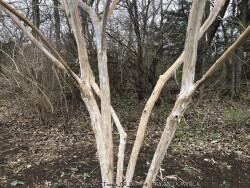

Hang on to your hat - Temple of Bloom® Seven-Son Flower (Heptacodium miconioides 'Temple Of Bloom') is going to blow your mind! We are thrilled to be able to bring this outstanding plant, previously known only by collectors and plant geeks, to everyone in North America. Temple of Bloom seven-son flower is a beautiful, easy to grow small tree which simply can't be matched for year-round beauty. In spring, the handsome leaves emerge, each sporting dramatically deep veins that make the plant stand out in the landscape. As the season progresses, the leaves grow larger and develop a long, twisting tip. Come August, when everything else is winding down, Temple of Bloom seven-son flower is just coming into its own, as it becomes covered in big clusters of fragrant white flowers that hummingbirds and other pollinators flock to. They last for weeks before gracefully falling to the ground to reveal vivid red, fan-like bracts, which make it look like the plant is blooming again in a completely different color. As winter comes and the leaves drop, the plant's elegant frame is revealed, along with amazing light tan peeling bark. Temple of Bloom® seven-son flower is the perfect choice for a special spot in your landscape. Plant it where it can be seen, often, and enjoyed any time of the year. Available in better garden centers in spring 2019. Top reasons to grow Temple of Bloom® seven-son flower: 1. Contribute outstanding interest to your home but needs little care. 2. Flowers in late summer and fall, when other plants are winding down. 3. Peeling bark looks great year-round but is especially memorable in winter. Temple of Bloomtm seven-son flower is at its best as a specimen, thanks to its elegant habit. Though its exact form will depend on how the grower has trained it, it is typically a small, multi-stemmed tree that reaches around 10' tall at maturity. Believe it or not, this beautiful and unusual plant requires essentially no care. It isn't finicky about soils, though it does appreciate regular moisture and good drainage. It will not require any special pruning, though you may prune or train it to your liking if you prefer. If you do prune it, do that in late winter or early spring, as the flower buds begin to set shortly after the plant leafs out. In Eastern Kansas, this cultivar performs WELL with just about everything nature has to challenge it! Heat and drought are tolerated in full sun or shade. Cold tolerance is no problem. No disease or pest problems. All Proven Winners® plants are legally propagated, healthy and vigorous, true to name, and tagged with color pictures and growing information.
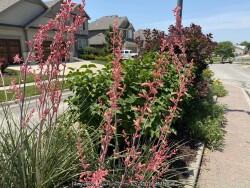

Texas Red Yucca (Hesperaloe parviflora) is a slow-growing broadleaf evergreen perennial with tall coral red flowers! Surprisingly, a native of Northeastern Mexico and Southwestern Texas can handle our extreme cold and wetness of Lawrence, KS! Normally thriving in hot, dry, desert conditions, is also surprisingly winter hardy to USDA Zone 5. Medium to blue-green leaves form rosettes about 2-3 feet tall and wide. Tall red flower spikes reliably appear on mature plants from July to October lasting 3-4 months in Kansas. If pollination is successful, attractive seed heads form later turning to black before cracking open in winter. Tough as nails, yuccas are the ideal plant for a no-maintenance garden. Normally a plant has specific requirements for success but this yucca has only a few: it cannot tolerate poorly drained soils, full shade, or North exposures. This and other yuccas look best when combined with other flowering plants providing texture and color. In mass plantings, red yucca can create an interesting architectural look. Combined with ornamental grasses, red yucca can create stunning contrasts with winter grass colors of pink, orange and rust. Red flowers are pollinated by hummingbirds and certainly deserve a place in native plant / pollinator garden. Not a true yucca, this is actually a Hesperaloe, a closely related genus also related to century plants. A large group of Hesperaloe survived -16 degrees F and a week of single digit highs in February, 2021 with no mulch. I have also seen miles upon miles of this plant growing in the medians along multi-lane interstates in Dallas. All plants were healthy looking with no missing or dying plants; truely a tough plant. Truely a 4-seasons plant for your yard!
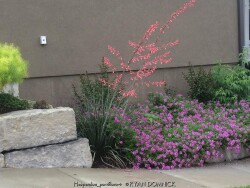

Texas Red Yucca (Hesperaloe parviflora) is a slow-growing broadleaf evergreen perennial with tall coral red flowers! Surprisingly, a native of Northeastern Mexico and Southwestern Texas can handle our extreme cold and wetness of Lawrence, KS! Normally thriving in hot, dry, desert conditions, is also surprisingly winter hardy to USDA Zone 5. Medium to blue-green leaves form rosettes about 2-3 feet tall and wide. Tall red flower spikes reliably appear on mature plants from July to October lasting 3-4 months in Kansas. If pollination is successful, attractive seed heads form later turning to black before cracking open in winter. Tough as nails, yuccas are the ideal plant for a no-maintenance garden. Normally a plant has specific requirements for success but this yucca has only a few: it cannot tolerate poorly drained soils, full shade, or North exposures. This and other yuccas look best when combined with other flowering plants providing texture and color. In mass plantings, red yucca can create an interesting architectural look. Combined with ornamental grasses, red yucca can create stunning contrasts with winter grass colors of pink, orange and rust. Red flowers are pollinated by hummingbirds and certainly deserve a place in native plant / pollinator garden. Not a true yucca, this is actually a Hesperaloe, a closely related genus also related to century plants. A large group of Hesperaloe survived -16 degrees F and a week of single digit highs in February, 2021 with no mulch. I have also seen miles upon miles of this plant growing in the medians along multi-lane interstates in Dallas. All plants were healthy looking with no missing or dying plants; truely a tough plant. Truely a 4-seasons plant for your yard!
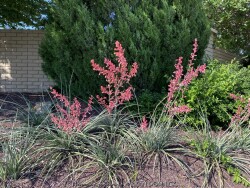

Texas Red Yucca (Hesperaloe parviflora) is a slow-growing broadleaf evergreen perennial with tall coral red flowers! Surprisingly, a native of Northeastern Mexico and Southwestern Texas can handle our extreme cold and wetness of Lawrence, KS! Normally thriving in hot, dry, desert conditions, is also surprisingly winter hardy to USDA Zone 5. Medium to blue-green leaves form rosettes about 2-3 feet tall and wide. Tall red flower spikes reliably appear on mature plants from July to October lasting 3-4 months in Kansas. If pollination is successful, attractive seed heads form later turning to black before cracking open in winter. Tough as nails, yuccas are the ideal plant for a no-maintenance garden. Normally a plant has specific requirements for success but this yucca has only a few: it cannot tolerate poorly drained soils, full shade, or North exposures. This and other yuccas look best when combined with other flowering plants providing texture and color. In mass plantings, red yucca can create an interesting architectural look. Combined with ornamental grasses, red yucca can create stunning contrasts with winter grass colors of pink, orange and rust. Red flowers are pollinated by hummingbirds and certainly deserve a place in native plant / pollinator garden. Not a true yucca, this is actually a Hesperaloe, a closely related genus also related to century plants. A large group of Hesperaloe survived -16 degrees F and a week of single digit highs in February, 2021 with no mulch. I have also seen miles upon miles of this plant growing in the medians along multi-lane interstates in Dallas. All plants were healthy looking with no missing or dying plants; truely a tough plant. Truely a 4-seasons plant for your yard!
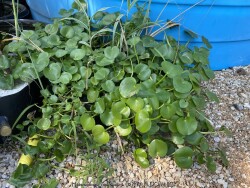

***Description for this perennial available with future update!*** Heteranthera reniformis is also known as Kidney-Leaved Mud-Plantain >>>>>This plant can also be used as a marginal aquatic plant growing in shallow water. It can also grow as a bog plant needing constantly moist soil rich in organic matter. As a rain garden plant, it will thrive is a depressed area in the landscape that collects rain water from a roof during spring and summer periods of rain but then go dormant if the water hole dries out completely.
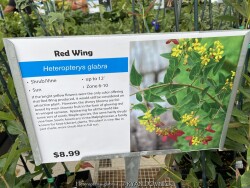

***Description for this plant available with future update!*** Heteropterys glabra is also known as Redwing Vine.
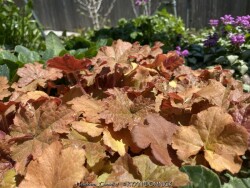

Caramel coral bells (Heuchera 'Caramel') are planted for its unusual orange-copper-peach evergreen leaf colors. Tiny light pink flowers also appear in early summer. Foliage maintains well as a non-spreading clump all year provided that certain cultural conditions are met. Native to Eastern U.S. forests in humusy, medium well-drained soil in part shade to full shade, it needs constantly moist soil rich in organic matter but avoid clay. Summer droughts and temperatures over 100 degrees F. are stressful for coral belles. If low temperatures hit -10 degrees F, foliage finally dies back to the ground and re-emerges in early spring. Useful in Kansas landscapes as a small scale groundcover in part shade or morning sun. Color is less intense in full shade. Generally this plant declines after a few years of Kansas climate but worth a try in perfect soils in well-tended shade gardens. Preferring northern climates, lack of moisture, alkaline soils, and competition with weeds seem to be an issue. 'Carmel' is a villosa hybrid with glowing golden-orange leaves turning a bit more apricot with warmer weather. Foliage is fuzzy giving the plants a more frosted look. For a coral bell, this cultivar is very heat and humidity tolerant; a vigorous grower. We have a specimen thriving in our Lawrence, KS, for over 10 years needing very little care; it gets morning sun, regular irrigation, and that's about it! All Proven Winners® plants are legally propagated, healthy and vigorous, true to name, and tagged with color pictures and growing information.
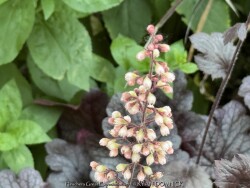

Obsidian Coral Bells (Heuchera x 'Obsidian') are planted for its unusual orange-copper-peach evergreen leaf colors. Tiny light pink flowers also appear in early summer. Foliage maintains well as a non-spreading clump all year provided that certain cultural conditions are met. Native to Eastern U.S. forests in humusy, medium well-drained soil in part shade to full shade, it needs constantly moist soil rich in organic matter but avoid clay. Summer droughts and temperatures over 100 degrees F. are stressful for coral belles. If low temperatures hit -10 degrees F, foliage finally dies back to the ground and re-emerges in early spring. Useful in Kansas landscapes as a small scale groundcover in part shade or morning sun. Color is less intense in full shade. Generally this plant declines after a few years of Kansas climate but worth a try in perfect soils in well-tended shade gardens. Preferring northern climates, lack of moisture, alkaline soils, and competition with weeds seem to be an issue. 'Carmel' is a villosa hybrid with glowing golden-orange leaves turning a bit more apricot with warmer weather. Foliage is fuzzy giving the plants a more frosted look. For a coral bell, this cultivar is very heat and humidity tolerant; a vigorous grower. We have a specimen thriving in our Lawrence, KS, for over 10 years needing very little care; it gets morning sun, regular irrigation, and that's about it! All Proven Winners® plants are legally propagated, healthy and vigorous, true to name, and tagged with color pictures and growing information.
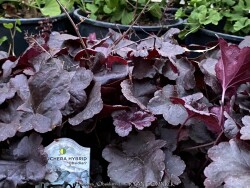

Obsidian Coral Bells (Heuchera x 'Obsidian') are planted for its unusual orange-copper-peach evergreen leaf colors. Tiny light pink flowers also appear in early summer. Foliage maintains well as a non-spreading clump all year provided that certain cultural conditions are met. Native to Eastern U.S. forests in humusy, medium well-drained soil in part shade to full shade, it needs constantly moist soil rich in organic matter but avoid clay. Summer droughts and temperatures over 100 degrees F. are stressful for coral belles. If low temperatures hit -10 degrees F, foliage finally dies back to the ground and re-emerges in early spring. Useful in Kansas landscapes as a small scale groundcover in part shade or morning sun. Color is less intense in full shade. Generally this plant declines after a few years of Kansas climate but worth a try in perfect soils in well-tended shade gardens. Preferring northern climates, lack of moisture, alkaline soils, and competition with weeds seem to be an issue. 'Carmel' is a villosa hybrid with glowing golden-orange leaves turning a bit more apricot with warmer weather. Foliage is fuzzy giving the plants a more frosted look. For a coral bell, this cultivar is very heat and humidity tolerant; a vigorous grower. We have a specimen thriving in our Lawrence, KS, for over 10 years needing very little care; it gets morning sun, regular irrigation, and that's about it! All Proven Winners® plants are legally propagated, healthy and vigorous, true to name, and tagged with color pictures and growing information.